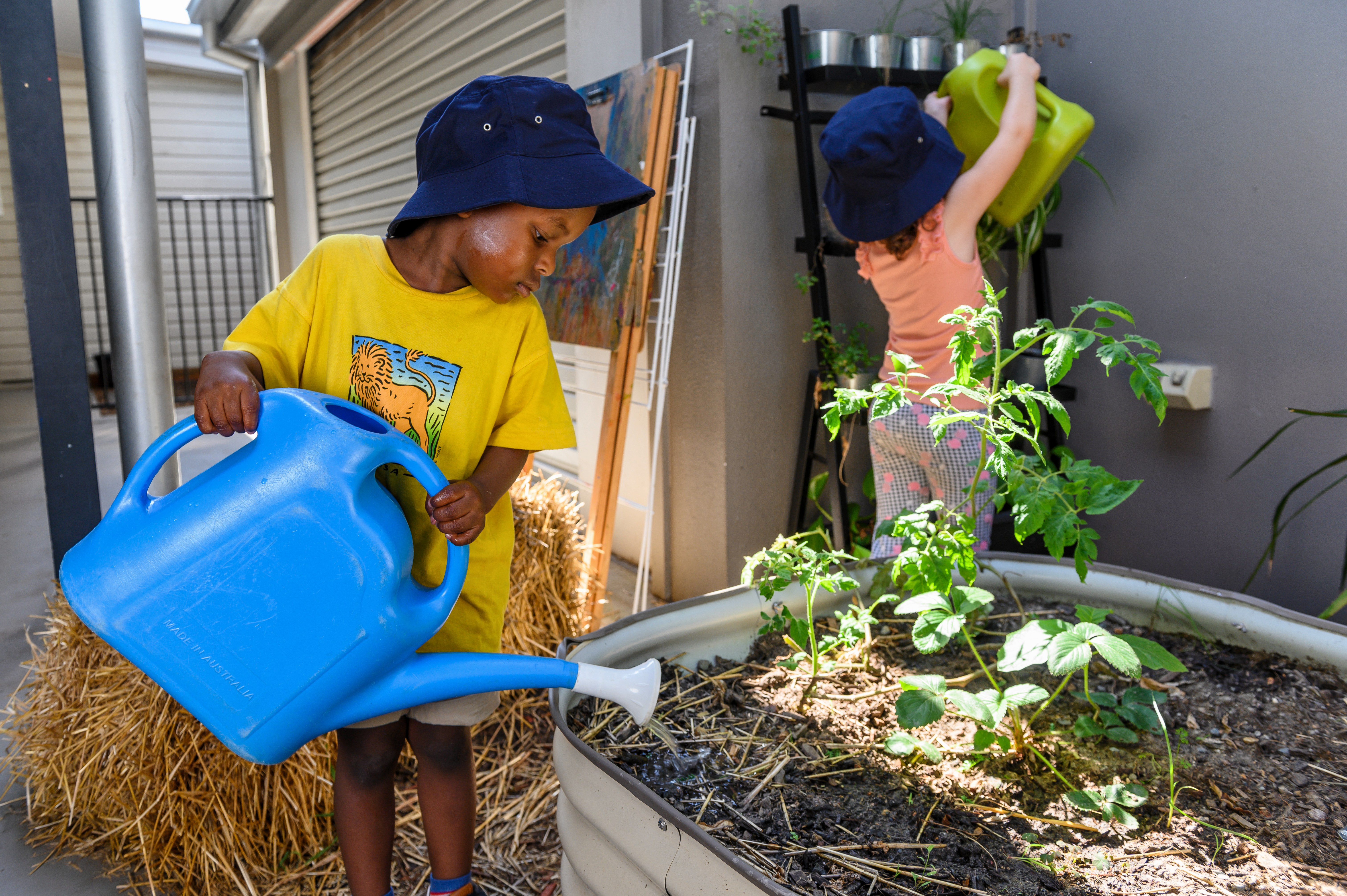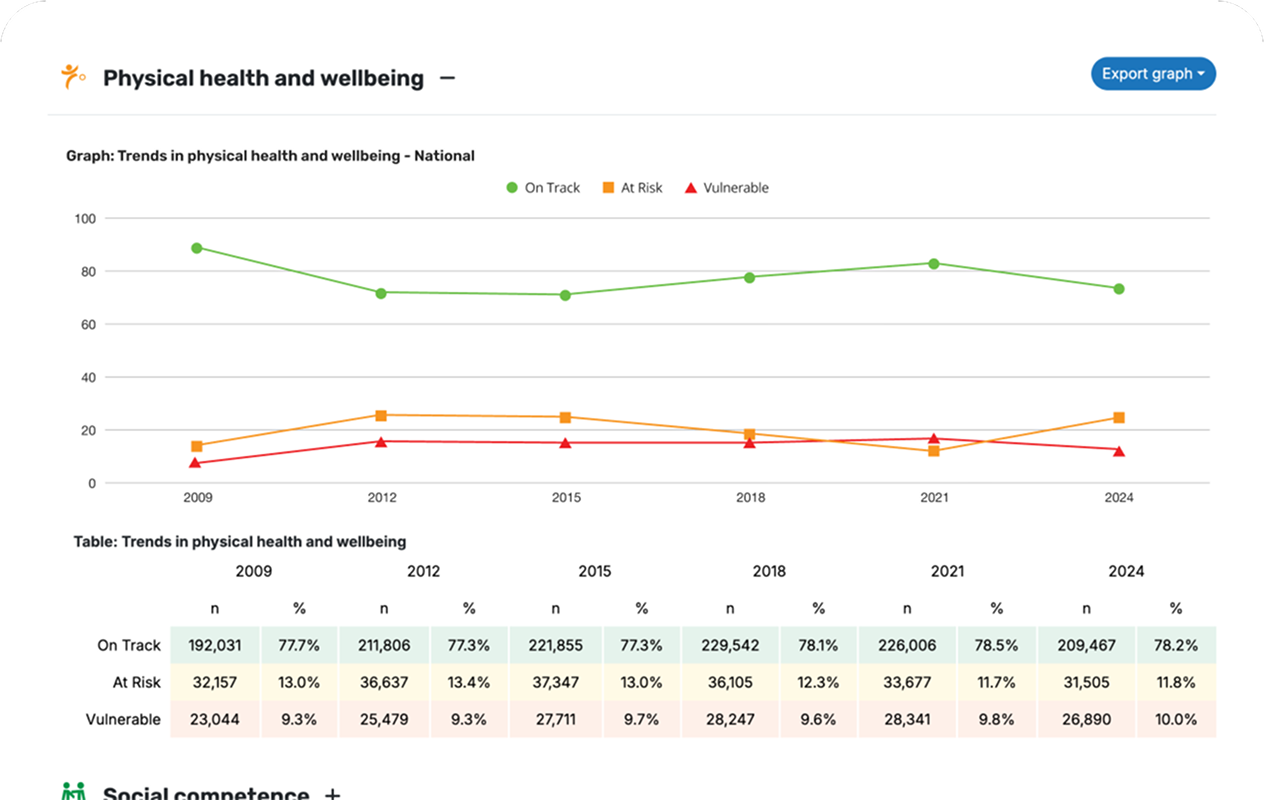
Date: June 2024
AEDC Cycle: Cycle 2 (2012), Cycle 3 (2015), Cycle 4 (2018), Cycle 5 (2021)
States: ACT, NSW, NT, QLD, SA, TAS, VIC, WA
Data Linkage Project: No
Organisation: Deloitte Access Economics
The review of the CCCFR grant (‘the Grant’) will consider the effectiveness of the Grant in meeting its current objectives, and how the grant can be redesigned to best support the expectations and needs of government, services, families and community.
As a part of the Review, the project will determine the impact of the CCCFR Non-Competitive Grant on supporting the following key objectives:
- improved workforce participation by vulnerable and disadvantaged families
- ensure equitable access to affordable child care services for families, in particular for Aboriginal and Torres Strait Islander children?
- improve early childhood development outcomes for vulnerable and disadvantaged children?
Date: January 2024
AEDC Cycle: Cycle 1 (2009), Cycle 2 (2012), Cycle 3 (2015), Cycle 4 (2018), Cycle 5 (2021)
States: ACT, NSW, NT, QLD, SA, TAS, VIC, WA
Data Linkage Project: No
Organisation: University of Western Australia
The Australian National Child Health & Development Atlas project will deliver a holistic data asset that will map data on children across Australia, enabling the visualisation, analysis, and monitoring of health and wellbeing metrics for children. The broad aim of this study is to develop a national online, interactive tool that maps geo-spatial information on children and young people’s health, development and wellbeing indicators to support policy, investment and planning decisions at a National, State and local level. The proposed platform will be available to researchers, policymakers, planners and decision makers across all States and Territories, as well as at a National level; with the intention to provide visibility of the health, development and wellbeing needs of children across the country. This visibility will provide more specificity and utility of the data available for public policy investment and commissioning decisions with the objective to optimise government, non-government and industry funds to have maximum impact on the lives of children and families. For example, service providers will be able to monitor the needs of communities, and ensure their programs and services are located in the areas of highest need, and State and Commonwealth government agencies will have ready access to data on children and young people.
Date: January 2024
AEDC Cycle: Cycle 1 (2009), Cycle 2 (2012), Cycle 3 (2015), Cycle 4 (2018)
States: SA
Data Linkage Project: No
Organisation: Department for Education (South Australia)
Location SA is the output of a collaboration of South Australian government agencies and related organisations, working together to use geospatial data – data that has an associated geographic component – to improve community services and support South Australia’s economic priorities. It houses a web platform of authoritative geospatial data in the ‘Map Viewer’. This is a public-facing application enabling stakeholders to visualise data in the Location SA repository to inform policy, planning and programs.
An AEDC data layer on Location SA makes robust child development data accessible alongside this local and contextual information from other agencies. This allows for a visualisation of the wide range of factors impacting on a child’s development. Better, integrated data such as this can lead to better targeted policy, planning and programs to support child development in South Australia.
Date: January 2024
AEDC Cycle: Cycle 1 (2009), Cycle 2 (2012), Cycle 3 (2015), Cycle 4 (2018)
States: NT
Data Linkage Project: No
Organisation: Menzies School of Health Research
The report will be publicly released in 2021 in both printed and electronic versions. The data reported will also be provided and presented in an Internet facing data platform (similar to the AEDC Data Explorer). This report will provide government, non-government and community stakeholders information to guide planning and decision making. It envisaged that it will continue to be revisited biennially to track progress over time.
Date: January 2024
AEDC Cycle: Cycle 1 (2009), Cycle 2 (2012), Cycle 3 (2015), Cycle 4 (2018)
States: VIC
Data Linkage Project: No
Organisation: University of Melbourne
The ultimate aim of the research is to combine recently produced data on frontier violence with other historical and modern-day community data to understand the geographic dispersion of community exposure to historical violence, the driving factors, the current-day outcomes and community-level protective factors (such as maintenance of culture and social capital). However, to be able to motivate support for such research, we need to first compile basic data infrastructure to conduct preliminary analysis to establish ‘proof of concept’ for the project.
The research questions are:
- How is community-exposure to historical frontier violence distributed throughout Australia?
- What are the main historical factors that explain the distribution across communities?
- What is the relationship between community historical exposure to frontier violence and child development outcomes today?
- To what extent has current-day connection to land, culture and language protected against the effects of historical trauma on child development?
Date: May 2015
AEDC Cycle: Cycle 1 (2009), Cycle 2 (2012)
States: ACT, NSW, NT, QLD, SA, TAS, VIC, WA
Data Linkage Project: Yes
Organisation: Joint study between: Telethon Kids Institute; University of Adelaide; University of New South Wales; Menzies School of Health Research; University of South Australia; Department of Education and Training; Tasmanian Department of Education; South Australian Department for Education and Child Development; New South Wales Department of Education and Communities; Australian National University; ACT Health; Northern Territory Department of Health.
The 2012 Australian Early Development Census (AEDC) data collection provides the first opportunity to look at shifts in child development outcomes over time in Australia. Some communities in Australia have seen significant improvements in their AEDC results between 2009 and 2012. However, in small communities there is a lot of movement in the AEDC results because better AEDC results for a couple of children can have a big impact on the overall results in a small community. The critical difference measure was developed in collaboration with the University of British Columbia to provide a guideline about “how big” a difference in the AEDC results between 2009 and 2012 is required to be considered statistically significant, given the numbers of children in the community. Using this critical difference measure, this work aims to identify AEDC communities (approximately equivalent to local government areas) in all states and territories of Australia that have shown a significant improvement (reduction) in the proportion of children developmentally vulnerable on one or more domains of the AEDC and to investigate potential reasons behind this change.
Date: January 2024
AEDC Cycle: Cycle 4 (2018)
States: VIC
Data Linkage Project: No
Organisation: Merri Health
Ready, Set, Prep! takes a systems change approach to improve outcomes for all children and families, with targeted interventions to address inequities for the most vulnerable cohorts. To inform approach for the next four years, the project aims to investigate whether the 2018 AEDC data varies by language background other than English (LBOTE), by sex and by starting age category (defined as early starting age, single year eligible, second year eligible and late start exemption). This will help to inform the new community co-designed vision for Ready, Set, Prep! across the north of Moreland, and any associated targeted interventions.
Date: January 2024
AEDC Cycle: Cycle 2 (2012), Cycle 3 (2015), Cycle 4 (2018)
States: VIC
Data Linkage Project: No
Organisation: Local Logic Place
Date: June 2014
AEDC Cycle: Cycle 1 (2009), Cycle 2 (2012), Cycle 3 (2015)
States: VIC
Data Linkage Project: No
Organisation: School of Population Health, University of Melbourne
Community Indicators Victoria provides a community wellbeing indicator framework with local level data. Data is made available as a resource for communities and policy makers. CIV is a collaborative project hosted by the McCaughey Centre, School of Population Health, University of Melbourne.
Date: June 2014
AEDC Cycle: Cycle 1 (2009), Cycle 2 (2012), Cycle 3 (2015)
States: SA
Data Linkage Project: Yes
Organisation: The University of Adelaide, School of Population Health
This project will examine trends in population health and development and underlying health determinants in SA. In particular it investigates the social, individual, clinical and family factors that influence school readiness and achievement including outcomes of traumatic brain injury; examines how social disadvantage and the Family Home Visiting (FHV) Program impacts on children's developmental outcomes; investigates Potential Preventable Hospital Admissions (PPAs) to hospital and emergency departments and examines these factors to develop an index of risk. It assist Government to interpret the data across collections to enhance program and service provision.
Date: June 2014
AEDC Cycle: Cycle 1 (2009), Cycle 2 (2012)
States: ACT, NSW, NT, QLD, SA, TAS, VIC, WA
Data Linkage Project: No
Organisation: The Royal Children's Hospital Melbourne
The Kids in Communities Study is an ongoing cross-disciplinary collaboration of experts from Canada and Australia established to address the potential benefit of community level factors influencing early childhood developmental outcomes. The project will investigate up to 10 communities across Australia, focusing where children are developing unexpectedly well or poorly when compared with socioeconomics of their suburb, to determine common factors related to neighbourhood level effects on child development.
Date: June 2014
AEDC Cycle: Cycle 1 (2009), Cycle 2 (2012)
States: ACT, NSW, NT, QLD, SA, TAS, VIC, WA
Data Linkage Project: No
Organisation: Goodstart Early Learning
Goodstart Early Learning operates 641 early learning and care centres across Australia. Goodstart Early Learning are currently developing a plan of centre-based programs and projects aimed at supporting social inclusion over the next three years. The timing and intensity of the centre's involvement in various programs and projects will vary, depending on each centre's community context. A key element of the community context is child development outcomes, as measured by the AEDI. Goodstart Early Learning will use the requested data, together with a range of other centre-level and community level data, to inform their planning of programs and projects.
Date: June 2014
AEDC Cycle: Cycle 1 (2009), Cycle 2 (2012)
States: NSW
Data Linkage Project: Yes
Organisation: University of New South Wales
The NSW Child Development Study is designed as a 15-20 year project to determine markers of early childhood development that represent vulnerability (or protective factors for) a variety of health, well-being and social outcomes in adolescence and young adulthood. The project combines record linkage with cross-sectional assessment of a NSW population of children for whom the Australian Early Development Census was completed in 2009. Improved knowledge of the relationship between early childhood function and later adult mental health will enable the identification of children at risk of a variety of adverse outcomes that may be mitigated by effective early intervention and prevention programs offered at critical stages of development.
Date: May 2014
AEDC Cycle: Cycle 2 (2012)
States: VIC
Data Linkage Project: No
Organisation: Robinvale District Health Services
Advancing Country Towns is a strategic program initiated through the Department of Economic Development, Jobs, Transport & Resources, Victoria. The Robinvale Advancing Country Towns project is run through Robinvale District Health Services and uses data including AEDC data to inform decisions around service integration, economic development and early year’s childhood education, with a particular focus on improving outcomes for Indigenous and ESL/CALD community members.
Community Data Explorer
Navigate the AEDC Community Data Explorer and understand the data.
